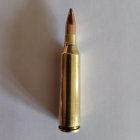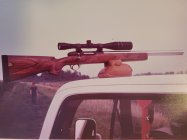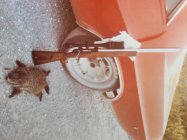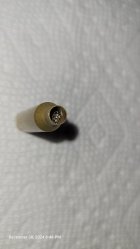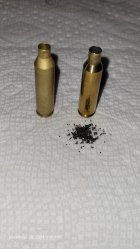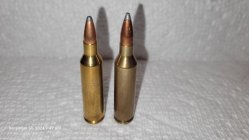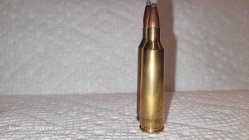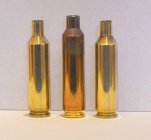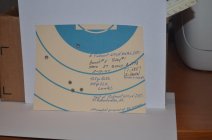.22-35 - A militarily-influenced wildcat.
Growing up, my Mother was always telling me …” Don’t exaggerate ! “
She must have told me, 10,000 times !!
What follows is no exaggeration, but…. might be considered “ Outside the box “:
As a Northeast Indiana farm boy, I was compelled to use a ballistic solution for the challenges posed by groundhogs. These robust, burrowing marmots don’t know they are supposed to die upon being shot, and can require some convincing. Local lore included stories like groundhogs being shot completely in-half…with the smarter half making it back to the hole. After making the first two kills using my Dad’s M-39 .22LR, up-gunning to a centerfire varmint cartridge became my #1 shooting priority. But, before I could take action on that; I enlisted with the local 122nd Fighter Wing of the Indiana Air National Guard at Ft.Wayne. As it turned out, the first centerfire rifle I shot, was an M-16 during basic training June 1972.
Spring 1973 I was 19 and well into my first year with the Air ‘Guard, when I talked to a local gunstore about my varmint rifle / cartridge needs. They sold me a custom Interarms Mk X action heavy-barrelled .22-250 varminter, that came out of P.O. Ackley’s shop in Utah. The purchase consumed all of my first Air ‘Guard 2 week “ Annual Training ” pay, and I still had a scope to buy ! I felt the Ackley custom varminter had great potential.
I shot Remington factory 55gr HP cartridges for the first two years. But even after I started shooting my own 55HP handloads… a point was reached where I wanted to apply a higher amount of terminal energy to groundhogs; than what my 24” .22-250 rifle/ammo provided. Yet, I still wanted to deliver that energy *using a well designed & well constructed .224” calibre 55gr varmint bullet; over typical engagement ranges. I reasoned the higher amount of energy would bolster my clean-kill capability on groundhogs at all sensible engagement distances, as long as I did my part. Then as now, my intent was to give these varmints clean kills; with no drama.
Looking at other factory .224” calibre offerings of the period, only .220 Swift had greater case capacity than the .22-250. Winchester stopped offering the ‘Swift as a mainline chambering, after touting its 4,000 fps velocity capability for 26 years…a velocity obtained shooting bullets of only 48gr weight. The .220 Swift case had a goofy rim, .043” of case taper, a shallow shoulder angle; and was l-o-n-g. For me, use of a factory .224” calibre cartridge was a no-go.
The gun store had a two volume treatise from P.O. Ackley titled “ Handbook for Shooters and Reloaders”. Ackley’s handbook included data on many .224” calibre wildcats known back then. I noted those with capacity greater than the .22-250 at-the-same-time leap frogged .220 Swift capacity by multiple grains. In result, .220 Swift-based wildcats like the .220 Arrow, and others like the .22 Rocket, .22-243, .22-284 et al; had greater capacity than what I had in mind. After reading through both volumes, it had become abundantly clear… to meet my varmint shooting needs, a custom rifle chambered in a new .224” calibre wildcat was the only way forward. More to the point, the new wildcat would be of my own design !
A lot of wildcats are undertaken specifically to achieve a certain amount of case capacity for a chosen calibre, which was my circumstance. More case capacity enables more stored energy, to allow increased velocity levels. I would tailor my wildcat to have case capacity greater than a .22-250, while at the same time have less capacity than a .22-250 AI. And, I wanted to obtain the capacity without having to “ blow out “ case’ shoulder diameters to get it. Along with that, I was determined to avoid design shortcomings I saw present in the .22-250 and .220 Swift.
My new Civil Service mechanic job working on F-100s based at Ft. Wayne, would fund the project. I was 20 and had been reloading for 2 years, when I stepped-off on my first wildcat !
The project began with my thinking about the “energy level-per-target size “ present, when shooting groundhogs with 55gr .224” cal varmint bullets @ hyper velocities. Groundhogs are tough critters, and can require a lot of terminal energy-per-target-size for a clean kill; even when afforded good shot placement with a great varmint bullet. To gain some perspective, I considered… what other real world shooting situation might this be compared to, if the greater than .22-250 energy BASELINE were scaled up for comparison to engaging a larger tough animal ? What amount of case capacity and level of “ terminal energy “ did the larger comparison animal usually require ? A larger, tough animal to do a scaled comparison with did come to mind…
I developed an algorithm for use in scaling case capacity and energy up incrementally from the baseline… for comparison with shooting Cape Buffalo using a large calibre/large powder volume rifle as the high-end reference. The resulting numbers overshot the top-end Cape Buffalo cartridge capacity and terminal ballistics data !
I realized, for better data match up; the comparison “ target “ would need to be smaller than “ Syncerus Caffer ". Also, a different top-end comparison case was needed, for the scaled numbers to better align. One that featured even larger capacity, to allow greater deliverable energy than spec’s for the first large rifle cartridge I referenced. What had greater capacity than a really large rifle case ?
The logical next step was to introduce capacity and achievable energy data on shells from the spectrum of small calibre cannons, as the high end benchmark of my scaling algorithm; while still using a theoretical human-sized target for the calculations. This imparted a “ Military influence “ to my wildcat’s design process.
The Plan:
- Identify the small calibre cannon round of sufficient case capacity and achievable energy, to serve as the benchmark starting point to run case’ dimension scaling math DOWNWARD from. Incrementally decrease brass “shell” dimensions FROM the chosen cannon round reference point, TO rifle case dimensions that would give me the capacity I desired for my wildcat; with .224” as final calibre.
- Select a suitable candidate rifle case to serve as my wildcat’s “ parent brass ”, that would provide the case diameters (and other case features I desired for my wildcat ) to achieve that case capacity. It just made sense !
My Dad was a bomber pilot in WWII, and his earliest missions were flown in the B-25G; which had a 75mm M3 cannon in its nose. Naturally, that was the first cannon round that came to my mind. Data on 75mm M48 and M61 shells indicated these provided too much energy, to serve as the starting point reference to scale down from. I next checked data on shells used in the 37mm M4 cannon found on WWII P-39 & P-63 aircraft. The 37mm M3 and M4 shells likewise provided way too much energy for a theoretical comparison target of human proportions, exceeding the needs of the math exercise.
My Air National Guard unit’s F-100 fighters were equipped with 20mm M-39 cannons. That gave me a bias towards trying data on 15.5mm - 40mm Military rounds in the algorithm. These would still develop considerable amounts of energy for use in my math, when input along with the same notional target size I had used for the 37 & 75mm shell calculations. Lighter calibre cannon shells typically featured reasonable shoulder angles, and were “ rimless “.... case features that I wanted present on my wildcat case.
I continued doing a “ run-off “ between data on various smaller calibre cannon shells. The resulting output numbers closed in on providing me clearer upper limits on case capacity and energy the comparison cannon round would have to offer, to serve as a valid starting point for my scaling case dimensions DOWN… to arrive at my new wildcat’s ultimate configuration.
Then came a real boost in my internal ballistics and wildcatting education. I bought and read a copy of “ Guns & Ammo 1974 Annual “, while performing my second 2 week “ Summer Camp “ with the ‘Guard. The G&A annual featured an extensive article titled “ The Powley Papers “. These “ papers “ included copies of tech articles, charts; and graphs authored by renowned ballistician Homer Powley ( inventor of the “ Powley Computer “).
Of those tech articles, I found his rifle “ Expansion Ratio “ charts and graph particularly informative. I ordered one of Homer’s analogue “ P.C.’s “ from Bob Hutton’s “ Rifle Ranch “, some 10 years before debut of first generation “ MAC “ and later “ Apple “ computers. Powley’s Computer came with an instruction manual for its operation. I also obtained copies of Hutton’s bullet ogive chart; and Ken Water’s case capacity tables. I ran lots of numbers through my Powley Computer, staying up many times well into the early morning hours; working on right-sizing my wildcat’s case capacity.
After reading up on all pertinent internal and external ballistics data I could find, I decided upon 450ft lb as the minimum amount of energy I’d apply to “ Soybeanus Digestus “ at distance. The threshold served as a “ guide “ during my wildcat design process. *That level of energy delivered by a well designed & well constructed 55gr varmint bullet would provide high confidence of clean kills, long as I did my part. Compared to an otherwise identical rifle chambered in .22-250, my wildcat rifle was going to generate more energy at the same engagement distance, and deliver the guideline 450 ft lb minimum energy a bit further out on range; when called for. Both constituted desirable ballistics improvements beyond the .22-250 level… major goals for my project.
During the year spent intently studying all this, I read an article stating that .222 Remington case dimensions would basically scale up to the .50 cal Browning Machine Gun round. Since I was actively doing cartridge dimension ” scaling “ myself, the above information helped me with further refine my wildcat cartridge design focus. I reasoned…. “ WHEN a .222 scales up to .50BMG, and… a .222 has notably less case capacity than a .22-250; THEN…..the capacity of my .224” wildcat design would logically correspond to a scaled-down version of a case that had greater capacity than a .50BMG case. That meant, the reference case I sought would feature capacity, dimensions; and energy capability lying within the spectrum of lighter calibre cannon rounds; and THAT… agreed with the wildcat design logic I had already been utilizing !
Powley talked about rifle Expansion Ratio ( ER ) in many of his technical writings. Looking at his ER chart in the Guns & Ammo 1974 Annual, Homer listed the following data: In 24” barrels, a .22-250 gave an ER of 6.1, the .220 Swift an ER of 5.6 ; and the “ .220 Rocket “ had an expansion ratio of 5.3. In the Powley Computer’s instructions manual, I note the following comments Mr. Powley made in regards to gun velocity; on pages 7- 8:
“ For conventional types of guns there are only three ways by which higher than normal velocities may be obtained “ :
3. “ For a given bullet weight, increasing the total volume of the gun by decreasing the Expansion Ratio
( ER ). This is the method most usually used successfully. For a given gun length the chamber is
increased in size. This causes more powder to be burned with more energy and increased velocity. However, the * lower limit for Expansion Ratio is usually about 5.“ Powley went on to say…
“ Some anti-aircraft guns have been made with a ratio as low as 4 “.
Even though my wildcat project was not predicated on attaining extreme velocities, I indeed had previously chosen bullet weight, barrel length, and calibre I wanted use for my wildcat; therefore…Powley’s 3rd note still applied. His 3rd note’s last sentence resonated with me; as anti-aircraft guns typically ARE small calibre cannons…the type of shells I was already reviewing for the top end reference point of my case scaling math.
I again recognized the strong Military influence on my case’s design ! I knew my wildcat’s chamber volume would keep my rifle’s ER above 5 ( Powley’s suggested lower Expansion Ratio limit ) in my chosen 24” barrel length; meaning... my rifle would not be“ over-bore “ capacity.
After buying a new-wave liquid crystal display pocket calculator with grains conversion function, I felt both well informed and well equipped to at last finalize my design for a superb .224” calibre “ Anti-groundhog “ wildcat.
Looking through Water’s case capacity tables, I quickly noticed .35 Remington ( Remington brand brass ) had case capacity that was ideal for use as my wildcat’s parent brass. I already had .35 Remington cases on hand, fired in my Marlin M-336. I cut the shoulder and neck off one case, and found out some enlightening facts: Case’ internal diameter at the cutoff point where the shoulder met the case side walls was .400”. That ID extended all the way down to approximately .010” above the internal case web; where ID expanded a bit to .401” .
.35 Remington was .308 bolt face compatible, and had less case taper + a wider shoulder diameter than either the .220 Swift or the .22-250; on a case o.a.l. just 008” longer than the latter. * Best of all, match up with my SCALED DOWN case’ dimensions was great ! I selected .35 Remington as the parent case.
For my "22-35 ", I kept shoulder location same as the stock .35 Remington. I went with an easy to form 26* shoulder angle, which along with the shoulder diameter served to keep case capacity higher than it would have been had I chosen a 28* or 30* angle. Shoulder angle and location, plus the 1.920” case o.a.l. together gave my wildcat a greater than “ one calibre “ neck length; with the powder combustion “ turbulence point “ located inside the case neck. With .35 Remington parent brass, I was able to reach my case capacity goal without having to “ blow out “ case shoulders to reach it; simplifying my first foray into wildcat case forming.
Initially, I referred to my new wildcat design using the numerical designation “ .22-35 “, along with my last name tacked-on at the end. Later, I simply referred to it as “ .22-35 Remington “, basically letting the name describe my wildcat’s lineage. I drew the first 2D side view of my wildcat Oct 1975 ( same year the 6PPC came out ). I put my best effort into making a case drawing for Clymer to use when machining my wildcat’s chamber and re-size reamers. Another detailed drawing of my wildcat case was sent to RCBS, for their use in making my custom case forming die set; and FL size + bullet seater reloading die set.
When looking for the right shop to make my custom rifle, I was thrilled to find world class riflesmith Fred Sinclair’s place was just 6mi away !! Fred agreed to build my varmint rifle, utilizing benchrest-grade rifle components and machining practices. Sinclair talked me out of using a sleeved XP-100 action, instead having me go with a then-new Wichita WBR1375 single shot action. Fred installed an AR-15 style extractor, a Ken Burns converted M-700 2oz trigger, and a .224” cal 24” Hart SS 5-groove 1-14 twist 1.375” straight bull barrel; along with a recoil lug and aluminum trigger guard he machined for the gun. The metal was bedded by Tom Meredith, who worked for Fred at the time. Dave Schwarze did the finish on the Bishop walnut/walnut laminate stock, after
I had personally reduced stock width and shaped a Wundhammer palm swell using hand tools. Nobody shooting groundhogs in the NE Indiana fields ( I knew of or encountered ) had anything like my gun. It was basically a 17lb benchrest rifle, but chambered in a large(r) capacity .224” cal wildcat. Sinclair called the gun “ Super Pig “. It was the first rifle with a stainless steel barrel, or custom action, or laminate stock; that I would see in the field. My rifle had all three ! I couldn’t wait to shoot it !!
The RCBS case forming die set worked great, and forming forces were negligible while operating my Rockchucker press. I used Lyman X2 shell holders in the press and also in my RCBS bench-mounted priming tool. The forming set necked-down parent brass first from .358” cal to .308, from .308” to .257” cal as the second step; and a third step down to .224” final calibre. I did no case annealing, before running the neck-down process. The case forming set included a dedicated inside neck ream die + reamer for use in reducing neck wall thickness of newly-formed .22-35 cases to my desired spec. Outside neck turning did little more than smooth the orange peel micro texture, and I ran .010” neck wall thickness. Sinclair reamed a case holder for my use when trimming .22-35 cases in a Wilson lathe. I maintained case o.a.l right @ the 1.920” design length. Chamfer and debur were performed using a cutter from WiIson , and I uniformed all case primer pockets using one of their uniforming tools. Fred also custom-reamed a Wilson case length gage and a bullet seater die for my use when assembling loads with a 1st GEN Sinclair arbor press. Sinclair had been machining custom aluminum primer holder trays for use with a LEE hand priming tool, and gave me one of his originals for my use. I did not need to full length size any of my newly-formed / un-fired .22-35 cases.
I made 5 inert sample cases as a reference for Fred’s use while cutting the chamber. My bullet of choice was Hornady’s redoubtable 55gr SPSX, seated .125” into the neck. IMHO - Hornady’s 55SX was / is the greatest .224” calibre anti-groundhog bullet ever ! Fred set up the barrel leade’ for my anticipated cartridge loading / reloading using that bullet, with its secant ogive positioned .002”’ off the lands; per his recommendation. The RCBS bullet seater die worked just fine when seating the exposed lead tip 55SX, as did the Wilson seater.
Case fire forming was accomplished concurrent with 100yd load testing, using 52gr HP Ron Fifer bullets.
I was able to completely fill the case with IMR 4350 under the custom 52gr HPs, and obtained superb accuracy when shooting CCI BR primers; along with safe pressure. I could not however, fill the case with 4350 under the heavier 55SX; without pressure becoming too high. That realization lead me into further range testing using powders with a slower “ burn rate “ than IMR 4350. I found a great 55SX field load when shooting WW760 and CCI Magnum primers.
I switched to FED Large Magnum Rifle Match primers ( GM215M ) when they came out, because they proved to shrink groups convincingly ! After firing 450 shots testing bullets of 50-63gr along with a variety of powders and primers, the 55SX-WW760-FED GM215M combo proved to be the best for my needs. I was not surprised, as Sinclair had masterfully set up my rifle specifically for the 55SX. Load density was in the lower 90s percentile. Large Rifle primers worked superbly in my wildcat-chambered single shot bolt action, as my groundhog shooting was not fast action or high volume; and brass life was thereby extended. It was time to take my “.22-35“ afield !
A memorable shot:
I had just got off from work @ the Air National Guard and went directly to my favorite groundhog fields, not far from our base at the airport. I met up with 5 other shooters in 3 total vehicles. We went to different parts of a huge soybean acreage, and then all took turns shooting as opportunities arose. Before my turn came up, I decided to change out of my BDUs ( “ battle dress uniform “ ) and into “ civies “. I was already in a t-shirt and had just dropped my BDU pants down around my ankles during a lull in traffic on nearby I-69; when a groundhog popped up @ 425yd… and it was MY turn ! With other shooters watching, and people again driving by on I-69 about 100yd behind me; I took the shot with confidence… and with my pants still down ! It was a clean kill, which silenced laughing from the .222 shooters there with me. And while that was not my first kill made with the gun; it fer sher was one of my favorites !
.22-35 case capacity allowed achievable velocities hundreds of feet per second beyond the velocity limit Hornady printed on a slip, and included in every box of .224” calibre SX bullets. My .22-35 skyrocketed the 55SX “ into the realm of un-real performance “ ! I did not have any “ crawlers “ when shooting the 55SX in my .22-35 and adhering to my 450ft lb energy threshold guide. I never needed to take a second or “ assurance “ shot. With the Sinclair- made .22-35 rifle, I was able to realize my accuracy, energy delivery; and lethality goals on groundhogs !
If you care to, you could can visually compare the .22-35 to pics of a couple example Military shell designs also from the 20th century…. the 15.5mm X 106 FN, and the 25mm X 193 “ Hotchkiss Rimless “. Note similarity in case proportions and shaping that my wildcat exhibits. You might also note the use of “secant ogive“ projectiles. Hmm…
Yeh… I’ve often been cited for “ Outside the box “ thinking .
My wife tells people... “ He doesn’t even know where the box IS “
With regards,
357Mag INDANG, MSGT, Ret.
More pics to follow....
Growing up, my Mother was always telling me …” Don’t exaggerate ! “
She must have told me, 10,000 times !!
What follows is no exaggeration, but…. might be considered “ Outside the box “:
As a Northeast Indiana farm boy, I was compelled to use a ballistic solution for the challenges posed by groundhogs. These robust, burrowing marmots don’t know they are supposed to die upon being shot, and can require some convincing. Local lore included stories like groundhogs being shot completely in-half…with the smarter half making it back to the hole. After making the first two kills using my Dad’s M-39 .22LR, up-gunning to a centerfire varmint cartridge became my #1 shooting priority. But, before I could take action on that; I enlisted with the local 122nd Fighter Wing of the Indiana Air National Guard at Ft.Wayne. As it turned out, the first centerfire rifle I shot, was an M-16 during basic training June 1972.
Spring 1973 I was 19 and well into my first year with the Air ‘Guard, when I talked to a local gunstore about my varmint rifle / cartridge needs. They sold me a custom Interarms Mk X action heavy-barrelled .22-250 varminter, that came out of P.O. Ackley’s shop in Utah. The purchase consumed all of my first Air ‘Guard 2 week “ Annual Training ” pay, and I still had a scope to buy ! I felt the Ackley custom varminter had great potential.
I shot Remington factory 55gr HP cartridges for the first two years. But even after I started shooting my own 55HP handloads… a point was reached where I wanted to apply a higher amount of terminal energy to groundhogs; than what my 24” .22-250 rifle/ammo provided. Yet, I still wanted to deliver that energy *using a well designed & well constructed .224” calibre 55gr varmint bullet; over typical engagement ranges. I reasoned the higher amount of energy would bolster my clean-kill capability on groundhogs at all sensible engagement distances, as long as I did my part. Then as now, my intent was to give these varmints clean kills; with no drama.
Looking at other factory .224” calibre offerings of the period, only .220 Swift had greater case capacity than the .22-250. Winchester stopped offering the ‘Swift as a mainline chambering, after touting its 4,000 fps velocity capability for 26 years…a velocity obtained shooting bullets of only 48gr weight. The .220 Swift case had a goofy rim, .043” of case taper, a shallow shoulder angle; and was l-o-n-g. For me, use of a factory .224” calibre cartridge was a no-go.
The gun store had a two volume treatise from P.O. Ackley titled “ Handbook for Shooters and Reloaders”. Ackley’s handbook included data on many .224” calibre wildcats known back then. I noted those with capacity greater than the .22-250 at-the-same-time leap frogged .220 Swift capacity by multiple grains. In result, .220 Swift-based wildcats like the .220 Arrow, and others like the .22 Rocket, .22-243, .22-284 et al; had greater capacity than what I had in mind. After reading through both volumes, it had become abundantly clear… to meet my varmint shooting needs, a custom rifle chambered in a new .224” calibre wildcat was the only way forward. More to the point, the new wildcat would be of my own design !
A lot of wildcats are undertaken specifically to achieve a certain amount of case capacity for a chosen calibre, which was my circumstance. More case capacity enables more stored energy, to allow increased velocity levels. I would tailor my wildcat to have case capacity greater than a .22-250, while at the same time have less capacity than a .22-250 AI. And, I wanted to obtain the capacity without having to “ blow out “ case’ shoulder diameters to get it. Along with that, I was determined to avoid design shortcomings I saw present in the .22-250 and .220 Swift.
My new Civil Service mechanic job working on F-100s based at Ft. Wayne, would fund the project. I was 20 and had been reloading for 2 years, when I stepped-off on my first wildcat !
The project began with my thinking about the “energy level-per-target size “ present, when shooting groundhogs with 55gr .224” cal varmint bullets @ hyper velocities. Groundhogs are tough critters, and can require a lot of terminal energy-per-target-size for a clean kill; even when afforded good shot placement with a great varmint bullet. To gain some perspective, I considered… what other real world shooting situation might this be compared to, if the greater than .22-250 energy BASELINE were scaled up for comparison to engaging a larger tough animal ? What amount of case capacity and level of “ terminal energy “ did the larger comparison animal usually require ? A larger, tough animal to do a scaled comparison with did come to mind…
I developed an algorithm for use in scaling case capacity and energy up incrementally from the baseline… for comparison with shooting Cape Buffalo using a large calibre/large powder volume rifle as the high-end reference. The resulting numbers overshot the top-end Cape Buffalo cartridge capacity and terminal ballistics data !
I realized, for better data match up; the comparison “ target “ would need to be smaller than “ Syncerus Caffer ". Also, a different top-end comparison case was needed, for the scaled numbers to better align. One that featured even larger capacity, to allow greater deliverable energy than spec’s for the first large rifle cartridge I referenced. What had greater capacity than a really large rifle case ?
The logical next step was to introduce capacity and achievable energy data on shells from the spectrum of small calibre cannons, as the high end benchmark of my scaling algorithm; while still using a theoretical human-sized target for the calculations. This imparted a “ Military influence “ to my wildcat’s design process.
The Plan:
- Identify the small calibre cannon round of sufficient case capacity and achievable energy, to serve as the benchmark starting point to run case’ dimension scaling math DOWNWARD from. Incrementally decrease brass “shell” dimensions FROM the chosen cannon round reference point, TO rifle case dimensions that would give me the capacity I desired for my wildcat; with .224” as final calibre.
- Select a suitable candidate rifle case to serve as my wildcat’s “ parent brass ”, that would provide the case diameters (and other case features I desired for my wildcat ) to achieve that case capacity. It just made sense !
My Dad was a bomber pilot in WWII, and his earliest missions were flown in the B-25G; which had a 75mm M3 cannon in its nose. Naturally, that was the first cannon round that came to my mind. Data on 75mm M48 and M61 shells indicated these provided too much energy, to serve as the starting point reference to scale down from. I next checked data on shells used in the 37mm M4 cannon found on WWII P-39 & P-63 aircraft. The 37mm M3 and M4 shells likewise provided way too much energy for a theoretical comparison target of human proportions, exceeding the needs of the math exercise.
My Air National Guard unit’s F-100 fighters were equipped with 20mm M-39 cannons. That gave me a bias towards trying data on 15.5mm - 40mm Military rounds in the algorithm. These would still develop considerable amounts of energy for use in my math, when input along with the same notional target size I had used for the 37 & 75mm shell calculations. Lighter calibre cannon shells typically featured reasonable shoulder angles, and were “ rimless “.... case features that I wanted present on my wildcat case.
I continued doing a “ run-off “ between data on various smaller calibre cannon shells. The resulting output numbers closed in on providing me clearer upper limits on case capacity and energy the comparison cannon round would have to offer, to serve as a valid starting point for my scaling case dimensions DOWN… to arrive at my new wildcat’s ultimate configuration.
Then came a real boost in my internal ballistics and wildcatting education. I bought and read a copy of “ Guns & Ammo 1974 Annual “, while performing my second 2 week “ Summer Camp “ with the ‘Guard. The G&A annual featured an extensive article titled “ The Powley Papers “. These “ papers “ included copies of tech articles, charts; and graphs authored by renowned ballistician Homer Powley ( inventor of the “ Powley Computer “).
Of those tech articles, I found his rifle “ Expansion Ratio “ charts and graph particularly informative. I ordered one of Homer’s analogue “ P.C.’s “ from Bob Hutton’s “ Rifle Ranch “, some 10 years before debut of first generation “ MAC “ and later “ Apple “ computers. Powley’s Computer came with an instruction manual for its operation. I also obtained copies of Hutton’s bullet ogive chart; and Ken Water’s case capacity tables. I ran lots of numbers through my Powley Computer, staying up many times well into the early morning hours; working on right-sizing my wildcat’s case capacity.
After reading up on all pertinent internal and external ballistics data I could find, I decided upon 450ft lb as the minimum amount of energy I’d apply to “ Soybeanus Digestus “ at distance. The threshold served as a “ guide “ during my wildcat design process. *That level of energy delivered by a well designed & well constructed 55gr varmint bullet would provide high confidence of clean kills, long as I did my part. Compared to an otherwise identical rifle chambered in .22-250, my wildcat rifle was going to generate more energy at the same engagement distance, and deliver the guideline 450 ft lb minimum energy a bit further out on range; when called for. Both constituted desirable ballistics improvements beyond the .22-250 level… major goals for my project.
During the year spent intently studying all this, I read an article stating that .222 Remington case dimensions would basically scale up to the .50 cal Browning Machine Gun round. Since I was actively doing cartridge dimension ” scaling “ myself, the above information helped me with further refine my wildcat cartridge design focus. I reasoned…. “ WHEN a .222 scales up to .50BMG, and… a .222 has notably less case capacity than a .22-250; THEN…..the capacity of my .224” wildcat design would logically correspond to a scaled-down version of a case that had greater capacity than a .50BMG case. That meant, the reference case I sought would feature capacity, dimensions; and energy capability lying within the spectrum of lighter calibre cannon rounds; and THAT… agreed with the wildcat design logic I had already been utilizing !
Powley talked about rifle Expansion Ratio ( ER ) in many of his technical writings. Looking at his ER chart in the Guns & Ammo 1974 Annual, Homer listed the following data: In 24” barrels, a .22-250 gave an ER of 6.1, the .220 Swift an ER of 5.6 ; and the “ .220 Rocket “ had an expansion ratio of 5.3. In the Powley Computer’s instructions manual, I note the following comments Mr. Powley made in regards to gun velocity; on pages 7- 8:
“ For conventional types of guns there are only three ways by which higher than normal velocities may be obtained “ :
- “ Increasing pressure. This is usually unsatisfactory because a 10% increase in pressure increases the velocity by only half such a percentage increase, namely 5%. “
3. “ For a given bullet weight, increasing the total volume of the gun by decreasing the Expansion Ratio
( ER ). This is the method most usually used successfully. For a given gun length the chamber is
increased in size. This causes more powder to be burned with more energy and increased velocity. However, the * lower limit for Expansion Ratio is usually about 5.“ Powley went on to say…
“ Some anti-aircraft guns have been made with a ratio as low as 4 “.
Even though my wildcat project was not predicated on attaining extreme velocities, I indeed had previously chosen bullet weight, barrel length, and calibre I wanted use for my wildcat; therefore…Powley’s 3rd note still applied. His 3rd note’s last sentence resonated with me; as anti-aircraft guns typically ARE small calibre cannons…the type of shells I was already reviewing for the top end reference point of my case scaling math.
I again recognized the strong Military influence on my case’s design ! I knew my wildcat’s chamber volume would keep my rifle’s ER above 5 ( Powley’s suggested lower Expansion Ratio limit ) in my chosen 24” barrel length; meaning... my rifle would not be“ over-bore “ capacity.
After buying a new-wave liquid crystal display pocket calculator with grains conversion function, I felt both well informed and well equipped to at last finalize my design for a superb .224” calibre “ Anti-groundhog “ wildcat.
Looking through Water’s case capacity tables, I quickly noticed .35 Remington ( Remington brand brass ) had case capacity that was ideal for use as my wildcat’s parent brass. I already had .35 Remington cases on hand, fired in my Marlin M-336. I cut the shoulder and neck off one case, and found out some enlightening facts: Case’ internal diameter at the cutoff point where the shoulder met the case side walls was .400”. That ID extended all the way down to approximately .010” above the internal case web; where ID expanded a bit to .401” .
.35 Remington was .308 bolt face compatible, and had less case taper + a wider shoulder diameter than either the .220 Swift or the .22-250; on a case o.a.l. just 008” longer than the latter. * Best of all, match up with my SCALED DOWN case’ dimensions was great ! I selected .35 Remington as the parent case.
For my "22-35 ", I kept shoulder location same as the stock .35 Remington. I went with an easy to form 26* shoulder angle, which along with the shoulder diameter served to keep case capacity higher than it would have been had I chosen a 28* or 30* angle. Shoulder angle and location, plus the 1.920” case o.a.l. together gave my wildcat a greater than “ one calibre “ neck length; with the powder combustion “ turbulence point “ located inside the case neck. With .35 Remington parent brass, I was able to reach my case capacity goal without having to “ blow out “ case shoulders to reach it; simplifying my first foray into wildcat case forming.
Initially, I referred to my new wildcat design using the numerical designation “ .22-35 “, along with my last name tacked-on at the end. Later, I simply referred to it as “ .22-35 Remington “, basically letting the name describe my wildcat’s lineage. I drew the first 2D side view of my wildcat Oct 1975 ( same year the 6PPC came out ). I put my best effort into making a case drawing for Clymer to use when machining my wildcat’s chamber and re-size reamers. Another detailed drawing of my wildcat case was sent to RCBS, for their use in making my custom case forming die set; and FL size + bullet seater reloading die set.
When looking for the right shop to make my custom rifle, I was thrilled to find world class riflesmith Fred Sinclair’s place was just 6mi away !! Fred agreed to build my varmint rifle, utilizing benchrest-grade rifle components and machining practices. Sinclair talked me out of using a sleeved XP-100 action, instead having me go with a then-new Wichita WBR1375 single shot action. Fred installed an AR-15 style extractor, a Ken Burns converted M-700 2oz trigger, and a .224” cal 24” Hart SS 5-groove 1-14 twist 1.375” straight bull barrel; along with a recoil lug and aluminum trigger guard he machined for the gun. The metal was bedded by Tom Meredith, who worked for Fred at the time. Dave Schwarze did the finish on the Bishop walnut/walnut laminate stock, after
I had personally reduced stock width and shaped a Wundhammer palm swell using hand tools. Nobody shooting groundhogs in the NE Indiana fields ( I knew of or encountered ) had anything like my gun. It was basically a 17lb benchrest rifle, but chambered in a large(r) capacity .224” cal wildcat. Sinclair called the gun “ Super Pig “. It was the first rifle with a stainless steel barrel, or custom action, or laminate stock; that I would see in the field. My rifle had all three ! I couldn’t wait to shoot it !!
The RCBS case forming die set worked great, and forming forces were negligible while operating my Rockchucker press. I used Lyman X2 shell holders in the press and also in my RCBS bench-mounted priming tool. The forming set necked-down parent brass first from .358” cal to .308, from .308” to .257” cal as the second step; and a third step down to .224” final calibre. I did no case annealing, before running the neck-down process. The case forming set included a dedicated inside neck ream die + reamer for use in reducing neck wall thickness of newly-formed .22-35 cases to my desired spec. Outside neck turning did little more than smooth the orange peel micro texture, and I ran .010” neck wall thickness. Sinclair reamed a case holder for my use when trimming .22-35 cases in a Wilson lathe. I maintained case o.a.l right @ the 1.920” design length. Chamfer and debur were performed using a cutter from WiIson , and I uniformed all case primer pockets using one of their uniforming tools. Fred also custom-reamed a Wilson case length gage and a bullet seater die for my use when assembling loads with a 1st GEN Sinclair arbor press. Sinclair had been machining custom aluminum primer holder trays for use with a LEE hand priming tool, and gave me one of his originals for my use. I did not need to full length size any of my newly-formed / un-fired .22-35 cases.
I made 5 inert sample cases as a reference for Fred’s use while cutting the chamber. My bullet of choice was Hornady’s redoubtable 55gr SPSX, seated .125” into the neck. IMHO - Hornady’s 55SX was / is the greatest .224” calibre anti-groundhog bullet ever ! Fred set up the barrel leade’ for my anticipated cartridge loading / reloading using that bullet, with its secant ogive positioned .002”’ off the lands; per his recommendation. The RCBS bullet seater die worked just fine when seating the exposed lead tip 55SX, as did the Wilson seater.
Case fire forming was accomplished concurrent with 100yd load testing, using 52gr HP Ron Fifer bullets.
I was able to completely fill the case with IMR 4350 under the custom 52gr HPs, and obtained superb accuracy when shooting CCI BR primers; along with safe pressure. I could not however, fill the case with 4350 under the heavier 55SX; without pressure becoming too high. That realization lead me into further range testing using powders with a slower “ burn rate “ than IMR 4350. I found a great 55SX field load when shooting WW760 and CCI Magnum primers.
I switched to FED Large Magnum Rifle Match primers ( GM215M ) when they came out, because they proved to shrink groups convincingly ! After firing 450 shots testing bullets of 50-63gr along with a variety of powders and primers, the 55SX-WW760-FED GM215M combo proved to be the best for my needs. I was not surprised, as Sinclair had masterfully set up my rifle specifically for the 55SX. Load density was in the lower 90s percentile. Large Rifle primers worked superbly in my wildcat-chambered single shot bolt action, as my groundhog shooting was not fast action or high volume; and brass life was thereby extended. It was time to take my “.22-35“ afield !
A memorable shot:
I had just got off from work @ the Air National Guard and went directly to my favorite groundhog fields, not far from our base at the airport. I met up with 5 other shooters in 3 total vehicles. We went to different parts of a huge soybean acreage, and then all took turns shooting as opportunities arose. Before my turn came up, I decided to change out of my BDUs ( “ battle dress uniform “ ) and into “ civies “. I was already in a t-shirt and had just dropped my BDU pants down around my ankles during a lull in traffic on nearby I-69; when a groundhog popped up @ 425yd… and it was MY turn ! With other shooters watching, and people again driving by on I-69 about 100yd behind me; I took the shot with confidence… and with my pants still down ! It was a clean kill, which silenced laughing from the .222 shooters there with me. And while that was not my first kill made with the gun; it fer sher was one of my favorites !
.22-35 case capacity allowed achievable velocities hundreds of feet per second beyond the velocity limit Hornady printed on a slip, and included in every box of .224” calibre SX bullets. My .22-35 skyrocketed the 55SX “ into the realm of un-real performance “ ! I did not have any “ crawlers “ when shooting the 55SX in my .22-35 and adhering to my 450ft lb energy threshold guide. I never needed to take a second or “ assurance “ shot. With the Sinclair- made .22-35 rifle, I was able to realize my accuracy, energy delivery; and lethality goals on groundhogs !
If you care to, you could can visually compare the .22-35 to pics of a couple example Military shell designs also from the 20th century…. the 15.5mm X 106 FN, and the 25mm X 193 “ Hotchkiss Rimless “. Note similarity in case proportions and shaping that my wildcat exhibits. You might also note the use of “secant ogive“ projectiles. Hmm…
Yeh… I’ve often been cited for “ Outside the box “ thinking .
My wife tells people... “ He doesn’t even know where the box IS “
With regards,
357Mag INDANG, MSGT, Ret.
More pics to follow....










